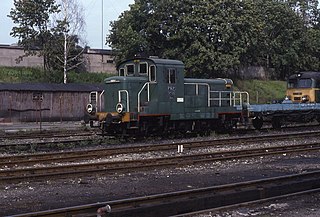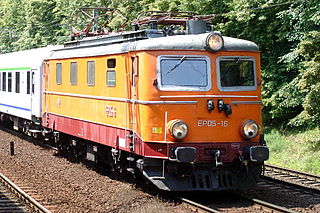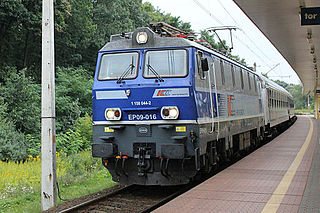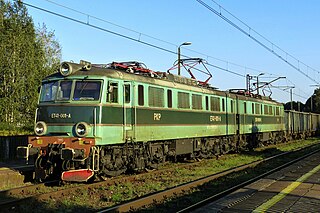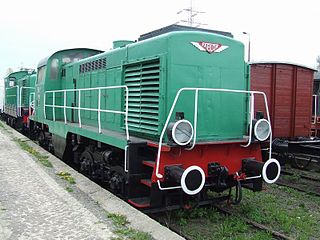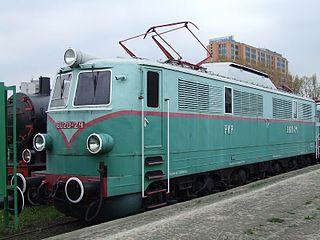This article relies largely or entirely on a single source .(December 2014) |
| EL.100 | |||||||||||||||||||||||||||
|---|---|---|---|---|---|---|---|---|---|---|---|---|---|---|---|---|---|---|---|---|---|---|---|---|---|---|---|
EL.103 locomotive | |||||||||||||||||||||||||||
| |||||||||||||||||||||||||||
| |||||||||||||||||||||||||||
| |||||||||||||||||||||||||||
| |||||||||||||||||||||||||||
English Electric EL.100 (Polish designations EP01, EL.100, E100 and E01) was a class of electric locomotives used by the Polish State Railways. Originally built and designed by English Electric as a line engine, it was used in Poland mainly for shunting, as a supplemental engine to ferry steam locomotives across the Warsaw Cross-City Line tunnel, between Pruszków and Otwock. It was the first electric locomotive used in Poland.

Polskie Koleje Państwowe SA is the dominant railway operator in Poland. The company was founded when the former Polskie Koleje Państwowe state-owned operator was divided into several units based on the requirements laid down by the European Union. PKP SA is the dominant company in PKP Group collective that resulted from the split, and maintains in 100% share control, being fully responsible for management of all of the other PKP Group component companies. The group's organisations are dependent upon PKP SA, but proposals for privatisation have been made.

An electric locomotive is a locomotive powered by electricity from overhead lines, a third rail or on-board energy storage such as a battery or a supercapacitor.
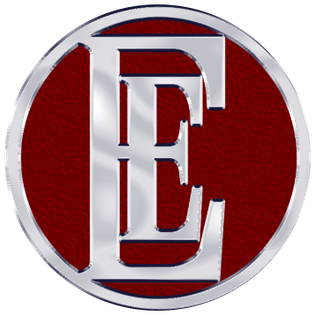
The English Electric Company Limited was a British industrial manufacturer formed after the armistice of World War I by amalgamating five businesses which, during the war, had been making munitions, armaments and aeroplanes.
First two engines were bought in the United Kingdom in 1933, additional four were license-built in First Locomotives Factory in Chrzanów, with the electrical machinery imported from England and mechanical part produced locally. The six locomotives, named EL.101 through EL.106, entered service on 15 December 1936. In early 1939 parts for additional four locomotives were ordered in the United Kingdom. Assembled for delivery in August 1939, they were captured in Gdynia by German forces during the Invasion of Poland and never completed.

Fablok is a Polish manufacturer of locomotives, based in Chrzanów. Until 1947 the official name was The First Factory of Locomotives in Poland Ltd., Fablok being a widely used syllabic abbreviation of Fabryka Lokomotyw. It is now named "BUMAR - FABLOK S.A. (corporation)". Fablok is located in the town of Chrzanów in Lesser Poland. As of 2009, Fablok no longer builds new locomotives.
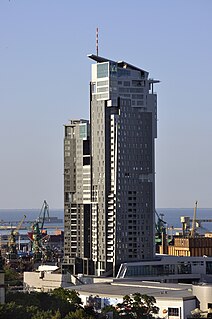
Gdynia(

The Invasion of Poland, known in Poland as the September Campaign or the 1939 Defensive War, and in Germany as the Poland Campaign (Polenfeldzug), was an invasion of Poland by Germany that marked the beginning of World War II. The German invasion began on 1 September 1939, one week after the signing of the Molotov–Ribbentrop Pact between Germany and the Soviet Union. The Soviets invaded Poland on 17 September following the Molotov–Tōgō agreement that terminated the Soviet and Japanese Battles of Khalkhin Gol in the east on 16 September. The campaign ended on 6 October with Germany and the Soviet Union dividing and annexing the whole of Poland under the terms of the German–Soviet Frontier Treaty.
During World War II, EL.103 was destroyed in 1939 and EL.101 was damaged beyond repair in 1944. Out of remaining four locomotives confiscated by the Nazis only EL.106 was returned to Poland and served in various capacities until 1964, under a new designation of EP01. EL.102, EL.104 and EL.105 remained in Germany and were scrapped in Desching some time after 1958.

World War II, also known as the Second World War, was a global war that lasted from 1939 to 1945. The vast majority of the world's countries—including all the great powers—eventually formed two opposing military alliances: the Allies and the Axis. A state of total war emerged, directly involving more than 100 million people from over 30 countries. The major participants threw their entire economic, industrial, and scientific capabilities behind the war effort, blurring the distinction between civilian and military resources. World War II was the deadliest conflict in human history, marked by 50 to 85 million fatalities, most of whom were civilians in the Soviet Union and China. It included massacres, the genocide of the Holocaust, strategic bombing, premeditated death from starvation and disease, and the only use of nuclear weapons in war.

